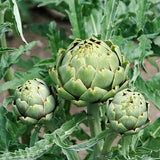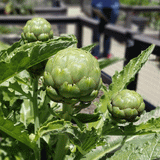50 Green Globe Artichoke Seeds
All multiple orders of the same seed are put in the same bag. For example if you order 500 beefsteak tomato seeds x 3 then 1500 seeds will be put in the same bag. We do not send out 3 individual bags with 500 in each. This goes for all seeds unless they are listings of different seeds.
NOTE: ALL GROWING INFO AND INSTRUCTIONS ARE ON ITEM PAGE.
Sowing: Stratify seeds by putting them in damp sand in the fridge for 2 weeks. Then germinate seeds indoors 8-12 weeks before last frost. Plant them 1/4" deep, in 4" pots, and keep the seedlings at a temperature of 60-70 degrees. Once they grow several leaves, expose them to temperatures lower than 50 degrees F for at 12-20 days; this process, called vernalization, acts as a false "winter" that enhances the growing process. Transplant the seedlings outside two weeks after the last spring frost. Space them 48" apart in rows 64" apart. Direct sowing the seeds outside after last frost also is an option, though it takes the plants longer to mature. Artichokes can also be fall planted, especially in warmer climates, since artichokes thrive in cool weather.
Growing: Take care to keep the young plants moist at all times and surrounded with mulch, compost, or straw. If fungus begins to form because of too much humidity, cut back on the water, and remove the affected leaves at once. Buds should begin to form about 120 days after transplanting, depending upon the climate. To overwinter this plant in warmer climates such as zone 7 and above, cover it thickly with mulch. Prevent excess moisture, as this often causes artichokes to die over winter. In zone 6 and colder, it will be necessary to dig up the plants by the roots, cut the stem to 3", and store them with the roots protected in a cool place until spring. Replant them after the last frost.









